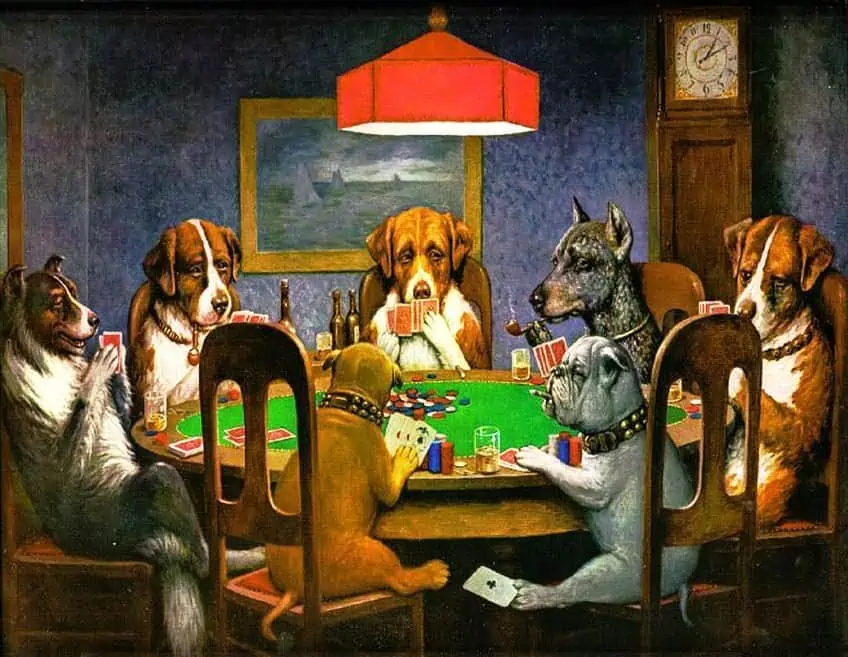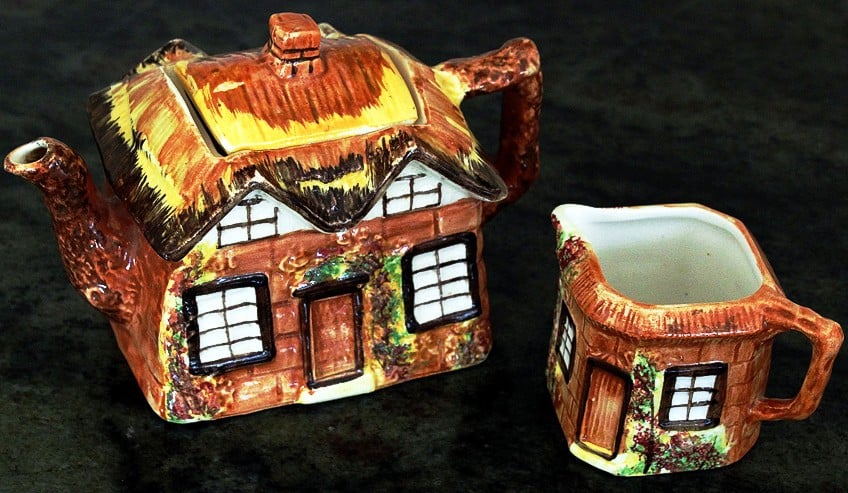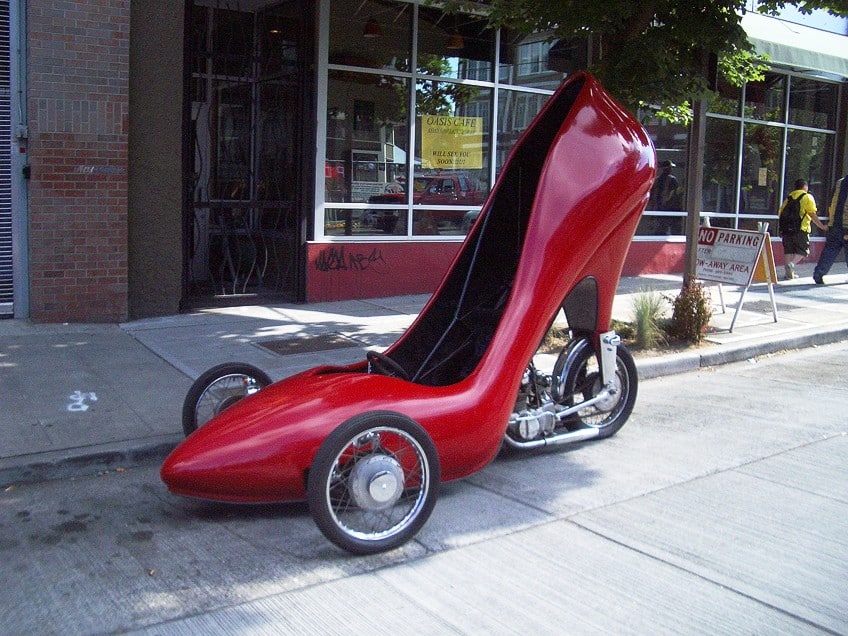Kitsch Art – Discover the Exciting World of Kitsch Art
What is Kitsch art? According to the Kitsch art definition, Kitsch art refers to design that is considered unsophisticated imitation, excessive, or of bad taste. The avant-garde rejected kitsch art as a shallow identification with the human condition and its banal ideals of beauty. Kitsch in art related to objects of pop culture that were seen to be lacking the substance of high art in the first half of the 20th century.
What Is Kitsch Art?
Kitsch has been re-appreciated in consciously satirical, comic, or sincere ways since the rise of Pop art in the 1950s. Kitsch is still a derogatory term for visual art, albeit not always. Kitsch art may be experienced in a completely pleasant and genuine sense. For example, it can be whimsical or eccentric without being objectionable on the exterior, as in Cassius Marcellus Coolidge’s series of famous kitsch paintings, Dogs Playing Poker (1903).
Kitsch emerged as a descriptive phrase in the art market of Munich, in the 1860s and 1870s, denoting inexpensive, fashionable, and marketable images and drawings.

Hans Reimann defined it as a technical expression “formed in a painter’s workshop” in Das Buch vom Kitsch (1936). Until the 1970s, practically all kitsch experimentation was conducted in Germany, with Walter Benjamin serving as a key figure on the subject. Kitsch is seen as a contemporary phenomenon, occurring at the same time as changes in society like the Industrial Revolution, mass production, urbanization, modern media and materials like plastics, television, and radio, the growth of the middle class, and state schooling.
These changes have all contributed to a perceived notion of an overabundance of art created for the general public’s taste.
Kitsch in Art Aesthetics and Theory
Hermann Broch, a modernist writer, claims that the core of kitsch is mimicry: kitsch imitates its immediate antecedent without concern for ethics – it strives to reproduce the attractive, not the virtuous. Kitsch, unlike fine art, is a utilitarian item that lacks any crucial separation between product and observer; it “offers quick emotional fulfillment without mental exertion, without the demand of detachment, without sublimation”, according to Walter Benjamin. Kitsch is more about the viewer than the item viewed.
“Kitsch is fraudulent art, conveying artificial feelings, whose purpose is to fool the customer into believing he experiences something profound and significant”, writes Roger Scruton.
Tomá Kulka begins with the two basic premises that kitsch has indisputable popular appeal and is seen negatively by the art-educated establishment, and then presents a few key conditions: Kitsch displays an attractive or highly emotive topic; the subject represented is quickly and easily identifiable; Kitsch does not significantly enrich our connections with the portrayed subject.

Kitsch art, according to many art critics, is defined by excessive emotion and melodrama. What all of these classifications have in common is that labeling visual work as “kitsch” is often derogatory. According to Benjamin’s interpretation, saying that a work of art is kitsch means that it is awful. Art and kitsch are incompatible. When a product is kitsch, it cannot be called art. What is the point of art if the spectator or viewer is unable to take a critical perspective, reflect, or observe something other than mere aesthetics? Art cannot be whittled down to only aesthetic satisfaction.
As a result, many scholars believe that kitsch artwork cannot be called art at all. It could, but it would be “poor” art.
Many modern artists, like Andy Warhol, Jeff Koons, and Yayoi Kusama, have been accused of incorporating kitsch aspects into their works. Despite being accused of “kitsch artworks,” these remarkable painters are among the most popular modern artists. On the other hand, there are several perspectives on Kitsch art.

If we accept that art is very subjective (some people adore Marina Abramovic’s work, while others despise it), we may draw a connection to kitsch art – what is kitsch to one individual may be great to another. Similarly, we frequently hear the phrase “I enjoy it, it’s so kitsch”. As a result, many artists purposefully incorporate kitsch in their works because they enjoy it and feel their viewers do as well.
The Kitsch Art Movement
Following our discussion of the ambiguities of the name Kitsch, we must highlight a movement known as The Kitsch Movement. Odd Nerdrum labeled himself a Kitsch artist in 1998, launching the movement of the same name. Kitsch, according to the movement, is identical to ancient Roman art or Greek techne. Kitsch artists accept it as a positive phrase: not as an antithesis to art, but as its unique autonomous movement with a solid philosophical foundation.
Nerdrum’s disciples include some of the most well-known artists of the Kitsch Art Movement, which has garnered a lot of attention and had multiple exhibits. So, after all that, kitsch art seems to be art in the end.

The Role of Kitsch Art in Society
Kitsch artworks are also believed to depict societal themes such as politics, environmental issues, and social environments. Kitsch as a commentary refers to the subject matter depicted in kitsch art. Despite the many critics, Thomas Kulka believes that if paintings were assessed democratically, kitsch as a style would undoubtedly triumph.
This begs the question of whose viewpoint matters: the public on whom we depend, or the art world? Preferences can be seen as political choices.

Kitsch, according to Kulka, also contains components that elicit “stock feelings”. This also conveys the concept that art may be created for anybody. In the fine art world, a message born of inclusion and revolt against an exclusivity complex is frequently evident. Kulka describes kitsch art as having “effortlessly recognized” common themes such as childhood, love, and family. Kitsch art depicts the accessibility and union of the upper-class affluence and the middle-class person.
Kitsch art was mass-produced into various products, and became a daily part of life in many families, widening the accessibility of art in general to individuals who would have previously been alienated from the appreciation of fine arts.
Famous Kitsch Paintings
Even great artists can make mass-produced artwork, in a state of perpetual garishness, with works created to have predicted widespread appeal. Nevertheless, quite often the artwork is so bad that it’s good. So, let’s take delight in the aesthetic appeal of nostalgia and sentimentality, and sink softly into the sugary sweet realm of famous Kitsch paintings.
Chinese Girl (1950) by Vladimir Tretchikoff
| Artist | Vladimir Tretchikoff (1913 – 2006) |
| Date | 1950 |
| Medium | Oil paint |
| Location | Private collection |
Tretchikoff arrived in South Africa in 1946, and two years later held his first painting show. His early works contain flowery still lifes and vibrant portraits of ladies, topics that he regarded to be instances of “symbolic realism.” Even though his work was not well received by the art establishment, Tretchikoff’s work was regularly presented during the following three decades, usually in department shops rather than specialized art galleries hence why it is regarded as one of the famous Kitsch paintings nowadays.
His fame grew as a result of highly successful exhibitions in Canada, the United States, and the United Kingdom, with a 1961 exhibition at Harrods of London garnering over 200,000 people.
In addition, his artwork Chinese Girl, which portrays an exotically clothed woman of Asian heritage with a contemplative look and blue-green complexion, became one of the most popular paintings of the mid-20th century, especially in South Africa and other Commonwealth nations.
Furthermore, the broad availability of replicas of his work resulted in sales during a career that elevated him to the ranks of the world’s wealthiest painters – so it seems that kitsch art isn’t all bad!
Return of the Sun (1986) by Odd Nerdrum
| Artist | Odd Nerdrum (1944 – Present) |
| Date | 1986 |
| Medium | Oil on canvas |
| Location | Private collection |
Three young ladies, a couple of which seem to be twins, are depicted on a precipice encircled by strange clouds in this Kitsch artwork. The women’s lips are agape as they grab for a light source beyond the frame of the image. Their eyes are open yet fully closed. Jan Ake Pettersson, an art historian, saw the picture as positive, interpreting it as a reflection of fresh energy following the breakdown of contemporary civilization.
Jan-Erik Ebbestad Hansen saw the painting’s sun as a metaphor for rebirth and a fresh start.
On the other hand, Barbara Vetland regarded the picture as gloomy in her master’s thesis, noting the general atmosphere, the color palette, the chasm in front of the ladies, and the assumption that they are blind and hence cannot see the light. “As a result, it is justified to wonder which sun Nerdrum has represented: the life-giving or the catastrophic?” Vetland wrote. Moving too near to the sun resulted in wrath and doom for Icarus’ arrogance.
According to Nerdrum, his paintings should be interpreted as kitsch instead of art.
Nerdrum’s manifesto On Kitsch discusses the contrast he makes between the kitschy and art. Among his pupils and followers, Nerdrum’s attitude has generated The Kitsch Movement, who refer to themselves as kitsch painters instead of artists.
Two Clowns (1989) by Bernard Buffet
| Artist | Bernard Buffet (1928 – 1999) |
| Date | 1989 |
| Medium | Oil on canvas |
| Location | Galerie Maurice Garnier, Paris |
Pablo Picasso was dining with his children on the patio of a restaurant in the south of France on a lovely day in the 1950s when yet another artist entered. “Hey, there’s Bernard Buffet”, Picasso’s children said. They sprang up and begged for the signature of the young, shy man, a painter who had amassed a massive fortune by the age of 30. However, following the artist’s stratospheric ascent to money and fame, Buffet fell victim to a blitz of denunciation in his native country in the 1960s, spearheaded, among many others, by Picasso himself.
The Spanish genius despised Buffet for rivaling his reputation, and he never forgave him for turning into a cult figure to his children – or perhaps they couldn’t sleep after seeing his kitsch clowns.
The Singing Butler (1992) by Jack Vettriano
| Artist | Jack Vettriano (1951 – Present) |
| Date | 1992 |
| Medium | Oil on canvas |
| Location | Private collection |
This Kitsch artwork has become one of the most well-known paintings of the previous decade. Few would deny the beautiful sweep of limbs and the lyrical concept of lovers waltzing the night away in each other’s arms, and this artwork has caught the imaginations and hearts of the people more than any other modern artwork.
According to reports, Vettriano has outsold every other painter, including Monet, in sales of prints and postcards of his work! The show was a huge success, and it led to the creator’s first exhibition, which was a sell-out in 1992.
The artwork is full of riddles and suggestions; the faces are either turned away, hidden or blurred, implying that they are not distinct persons but rather characters into whom we might all put our personalities. The melody of the eponymous butler is not mentioned, but we may presume it is a love ballad. A link may also be drawn between Vettriano’s works and that of the Hungarian photographer Brassai, who, in his exquisite photos of Parisian life, probed the profound romantic and sexual ambiguities of figure groupings.
The vast beaches and elegantly dressed, yet wind-swept individuals also evoke the works of 19th-century painter Eugene Boudin.
Balloon Dog (1994 – 2000) by Jeff Koons
| Artist | Jeff Koons (1955 – Present) |
| Date | 1994 – 2000 |
| Medium | Polished stainless steel |
| Location | Five various versions |
The concept of reflection is central to Jeff Koons’ motivation and work. He says he’s always been interested in light and how it bounces off things. In addition, he claims to have always experimented with reflective materials. Andy Warhol and Salvador Dalí are two of the artist’s main influences, according to the artist.
Jeff Koons’ work is sometimes compared to Pop Art, an art movement that utilized common things to create provocative art.
Early on, Koons became acquainted with the works of Salvador Dalí and began painting in his style. He is frequently likened to his contemporaries, Damien Hirst. Although Jeff Koons has stated several times that his works have no hidden messages, many art critics have sought to explain what makes this inflatable dog more meaningful than it appears. With its one-ton mass, Jeff Koons has claimed to be playing with the concept of a massive item with a light look with this sculpture – normally a transitory thing that becomes indestructible in this case. While being big and intimidating, Koons’ art is a throwaway toy.
These items are recognizable to us, but they become unsettling when displayed in a gallery or museum. Koons also stated that his Kitsch artwork represents the human experience: that humans, like these inflated objects, inhale air. Air, like these balloons, is essential to humans. One thing is certain: Jeff Koons likes to keep his art light and playful.
Despite this infantile element, it is difficult to deny that these artworks are famous for the exorbitant amounts at which they were purchased.
Critics erupt when the innocence and purity of a children’s toy become a sales record. Jeff Koons’ name is frequently connected with the word “kitsch”, describing his artworks as items that claim to be art but lack complexity or nuance. Furthermore, the fact that he does not create his works yet manages to sell them for exorbitant rates is contentious.
Based on the kitsch art definition, the term “kitsch” was used in the 19th century to describe work that was perceived as being in poor style or that hopelessly mimicked “high art” but remained inferior or wanting in sophistication. With the growth of industrial production in the 20th century, the phrase became more broadly connected with mass items or cheap leisure, deemed ornamental or reminiscent of lowbrow tastes. When Clement Greenberg raged against kitsch in a famous 1939 article, he said it was anathema to revolutionary, avant-garde art because it pandered to the public.
Frequently Asked Questions
What Is Kitsch Art?
If we look at the kitsch art definition, kitsch art is thought to be mass-produced art that has no value other than aesthetic appeal. The growth of consumer culture in Europe and the United States in the 1950s and 1960 sparked an artistic curiosity in pop culture, often with the goal of bridging the gap between presumably fine art and public appeal; but nowhere is this more evident than with the emergence of Pop Art in the United States. Today, the notion that something may be so awful that it’s good is so popular that the name kitsch no longer has the negative connotations it once did, and artists frequently make works that celebrate bad style and challenge the high-and low-brow divide in art.
What Is the Kitsch Movement?
Odd Nerdrum branded himself a kitsch painter in 1998, effectively beginning the Kitsch movement. Based on the ideals of the movement, kitsch artists embrace it as a good thing: not as an opposition to art, but as a distinct standalone movement with a clear theoretical foundation. Nerdrum’s students include some of the most well-known painters of the movement, which has received a great deal of attention and has had several shows.
Jordan Anthony is a Cape Town-based film photographer, curator, and arts writer. She holds a Bachelor of Art in Fine Arts from the University of the Witwatersrand, Johannesburg, where she explored themes like healing, identity, dreams, and intuitive creation in her Contemporary art practice. Jordan has collaborated with various local art institutions, including the KZNSA Gallery in Durban, the Turbine Art Fair, and the Wits Art Museum. Her photography focuses on abstract color manipulations, portraiture, candid shots, and urban landscapes. She’s intrigued by philosophy, memory, and esotericism, drawing inspiration from Surrealism, Fluxus, and ancient civilizations, as well as childhood influences and found objects. Jordan is working for artfilemagazine since 2022 and writes blog posts about art history and photography.
Learn more about Jordan Anthony and about us.
Cite this Article
Jordan, Anthony, “Kitsch Art – Discover the Exciting World of Kitsch Art.” artfilemagazine – Your Online Art Source. December 20, 2022. URL: https://artfilemagazine.com/kitsch-art/
Anthony, J. (2022, 20 December). Kitsch Art – Discover the Exciting World of Kitsch Art. artfilemagazine – Your Online Art Source. https://artfilemagazine.com/kitsch-art/
Anthony, Jordan. “Kitsch Art – Discover the Exciting World of Kitsch Art.” artfilemagazine – Your Online Art Source, December 20, 2022. https://artfilemagazine.com/kitsch-art/.



